Rasnov Citadel
Situated on the Brasov-Rucar-Campulung road,  Rasnov Citadel is one of the best preserved rustic citadels from Transylvania. Rasnov Citadel was at first called “Rustic Citadel”, because the main occupation of its constructors was agriculture.
Rasnov Citadel is one of the best preserved rustic citadels from Transylvania. Rasnov Citadel was at first called “Rustic Citadel”, because the main occupation of its constructors was agriculture.
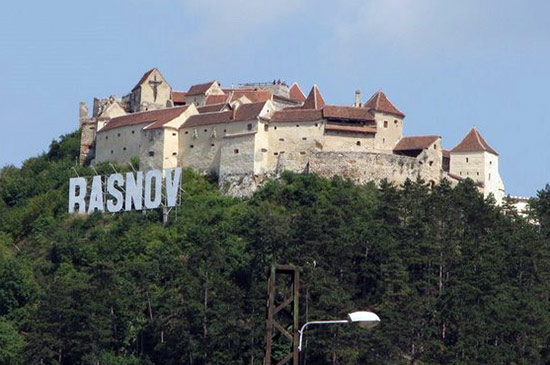
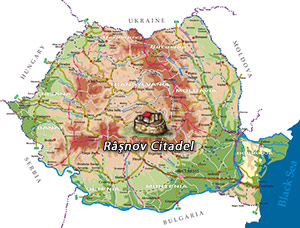
The rustic fortresses were part of a defending system of the Transylvanian places that were exposed to invaders’ attacks.
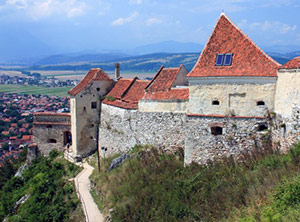
The place called Rasnov is mentioned for the first time in documents that date from the 12th century (year 1331). And during the Middle Ages and Modern Ages, Rasnov was one of the 12 villages that formed the district of Brasov, district that was mentioned in documents for the first time in 1377. Rasnov started to progress in the 13th century, but due to the Tartarian invasions in 1241, its developing ceased, as Burzenland (Tara Barsei) was ravaged. In order to defend themselves from the future invasions and from the feudal noblemen’s violations, the inhabitants of Rasnov built up a retreat and defense fortress on the top of a hill situated nearby.
An interesting fact about Rasnov is that when the invading armies came to Transylvania through Bran Pass, they first entered to the town of Rasnov. The only chance of survival for the people living around the area, including the inhabitants from Cristian and Ghimbav, was to retreat in Rasnov Citadel.
The citadel was first mentioned in documents in 1335, when Burzenland was again ravaged by the Tartarian armies, except for two fortresses: Tampa and Rasnov. These two couldn’t be conquered.
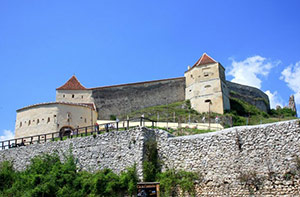
Being situated on the trading road that linked Transylvania to Walachia, the town of Rasnov was always opened to an early economical development. Its placement had been a transit trading place since 1427. Even Sigismund of Luxemburg gave the permission that a weekly fair should be organized. This fair was one of the most important economic centers from the South of Transylvania, as in this way, Transylvania kept its connections to the South-Eastern Europe.
Rasnov Citadel presents a simple architectonic style, closed to the structure of the ordinary houses and being adapted to the fortification conditions. The medieval atmosphere is even nowadays present, after 500 years of existence. For building the fortress, stone and brick were used. The height of the walls is 5 meters and the southern wall is the thickest (being 1m and a half thick in some places).
{banner-transilvaniaen}
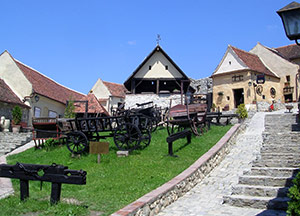
The walls, just like the towers, were covered with tile in order to prevent the fires caused by the invaders. The walls are irregularly lined up because of the dumped ground from the bottom of the hill, fact which gives the fortress the impression of a massive notched belt.
The citadel consists of an external enclosure placed in front of the eastern wall which is surrounded by a fortified wall and equipped with a square-shaped tower and of an internal enclosure which is surrounded by the walls and the towers of the fortress.
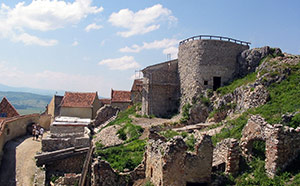
From north, south and west, the walls are bounded by the abrupt slopes that are almost 150 m high are that are very dangerous to climb. The whole superior enclosure is defended by external towers which are grouped on the northern and western sides. The eastern part of the citadel was more vulnerable regarding the natural obstacles, because it was saddle-shaped and for this reason, it was easier to pass. For strengthening the defense, the citadel presents in this respect the most outstanding fortifications.
The western, northern and eastern sides were protected by a large gallery, two ante forts and seven towers and on the southern side are there two towers.
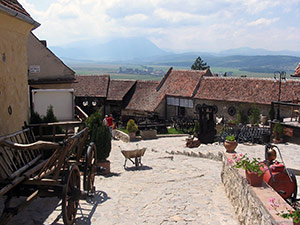
In the inner court one may see stony narrow paths that wind along through the houses covered with tile. Street lamps that are placed on the tall walls lighten the paths. In the enclosure, the ruins of more than 30 houses are kept. These ruins are meant to serve as a shelter place for the inhabitants and for their goods. The school, the chapel and the house of the priest are worth mentioning.
Only one single time in the history had the people from Rasnov to capitulate. This happened during Prince Gabriel Bathory’s reign in 1612 because of the lack of water. The opposing troops found out about a secret road to an offspring that represented the main source of water for the inhabitants of the fortress.
The fortress hosted in 1600 Michael The Braves’s troops together with his wife, Stanca, after his defeat at Miraslau.
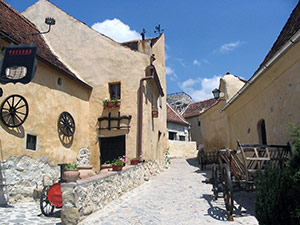
The archaeological researches from 1970 and even the most recent ones have discovered a rectangular-shaped chapel, having a semi-circular apse. It is believed that that chapel is in fact the Saint Gheorghe Chapel, mentioned in documents that date from the 14th century.
Inside the yard, the tourists may visit the Feudal Art Museum where lots of items are exposed: armors, weapons, medieval furniture pieces, traditional clothes specific to the century and several items that are a little unusual for us living nowadays : a torture mask and a yoke meant for the transport of the prisoners. You can try your skill in target shooting using an arrow bow. One may buy many souvenirs: jewelry made of semi-precious stones, art items and books presenting the history and the customs of the area.
The tourists that want to offer something to the fortress can plant rose seeds in a small square from the inner yard. In return, the name of the tourist will be written on a board that will be placed near the sewn flower.
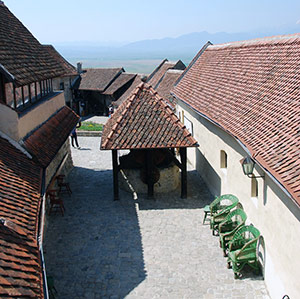
The legend of the well
The lack of water led to serious problems for long periods of times, so therefore, in 1625 the decision was taken that a well should be dug. The well from the fortress is 146 meters deep and was dug between 1625-1640. A church was founded there as well, in 1640.
There is a legend about this well, legend that is familiar to that about Hunyadi Castle. The legend says that during a siege, the inhabitants forced two Turkish prisoners to dig a well in the centre of the fortress, in order to gain their freedom again. The prisoners dug the well for 17 years and while doing this, they wrote verses from the Koran on the walls of the well. In fact, the well was looked after by the Transylvanian artisans, who were in the service of the townhall from Rasnov. The well was in use till 1850, when people abandoned it, because the wheel snapped. The well assured the fine living of the population from the fortress and “granted” them a high level of security, because they didn’t have to go outside the fortress in order to get their water supplies.
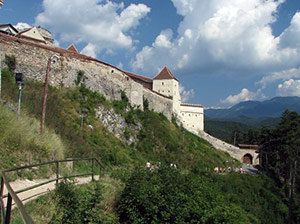
Short history
1335 – The first historic attestation of Rasnov Citadel
1421 – The first siege of a Turkish army against Rasnov Citadel
1427 – King Sigismund of Luxemburg paid a visit to Rasnov Citadel
1600 – Michael The Brave and his wife retreated here after his defeat at Miraslau. He then named Rasnov “the town of my reign”
1612 – Having no more water, the defenders of the fortress were forced to surrender to the army of Gabriel Bathory, the Prince of Transylvania, known as an enemy for the Transylvanian Saxons(sasi).
1625-1640 – The well was dug in the centre of Rasnov Citadel
1658-1661 – Due to the invasions, the people from Rasnov retreated here for three years
1659 – The Chapel from the fortress was built
1718 – The citadel was partially destroyed by a fire and in 1802 it was damaged by an earthquake
1821 – The refugees from Walachia retreated in the fortress (the revolutionary movement led by Tudor Vladimirescu)
1848-1849 – The Hungarian revolutionists and the Imperial Austrian troops passed through Rasnov; the inhabitants decided to retreat into the fortress (this was the last time when the citadel served as refuge and defense place for the people of Rasnov)
1850 – Due to the political situation and because the citadel wasn’t considered a shelter anymore, it was finally abandoned and became a ruin during the years. There was only one guardian in the fortress that had the duty to announce the people when it was a fire.
{tours-banner-scroll}
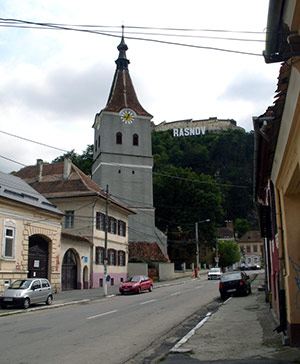
The tourist objectives situated nearby
The Evangelic Church is situated in the centre of Rasnov. It was built in the 13th century and the mural paintings date from the 16th century.
The Roman camp from Cumidava: this Dacian place lies on the farming territory of Rasnov town, nearly 500 meters away from the river Barsa. The Roman camp discovered here was built in the beginning of the Roman domination. Its role was to watch over the entrance ways from the mountains into Burzenland. Cumidava is a settlement that was named by the geographer Claudius Ptolemeu from Alexandria as “one of the shinning cities from Dacia”
The Equestrian Festival and The Days of Rasnov take place at the beginning of summer and are organized by the townhall of Rasnov, in collaboration with the District Council of Brasov. Parades of Romanian folk dancers, horse and coaches demonstrations, training of horses, everything is accompanied by traditional dances and songs.
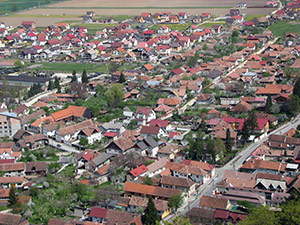
The Orthodox Church with the cemetery of the heroes. It was built in 1384 and hosts a small museum.
The Rasnov Gorges: here you can do bungee-jumping, roping down. You can also drive an ATV or to climb the mountains.
Old Transylvanian Saxon houses: there are many houses of this kind on the streets of Rasnov. They are 100-200 years old.
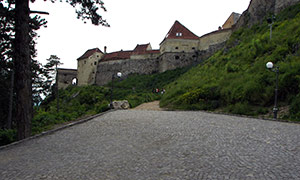
How to get there?
After you arrive in the town Rasnov, you’ll have to get to Unirii Boulevard. From there on, you have to go up on the winding road and then you’ll find yourself in front of the gates of the fortress. Even at the entrance of the fortress, you may admire the plain of Burzenland and the peaks of the Bai and Bucegi Mountains.
The road can be covered by car and there is a parking lot at the bottom of the fortress.
Visiting programme: Daily 9:00 AM – 7:00 PM
Entrance Fee: 10 lei adults; 5 lei children 7-18 years
Photo Fee: free
Binoculars coins: (displayed on the observation point of the Citadel): – 2 lei
Inside the citadel there is a restaurant.
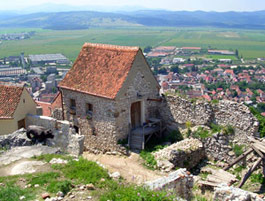
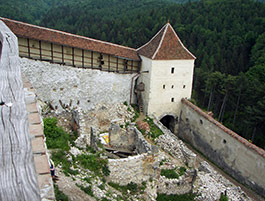
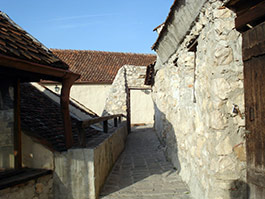
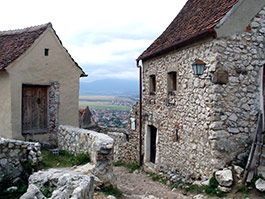
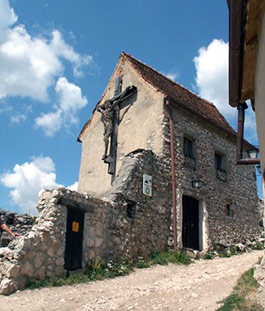
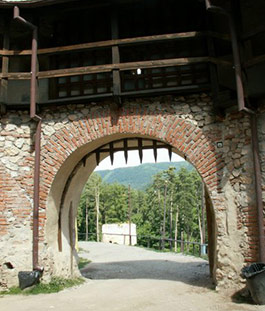
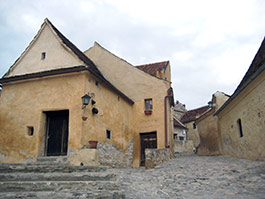
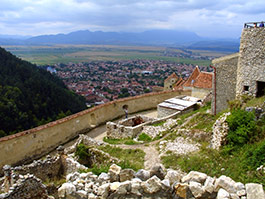
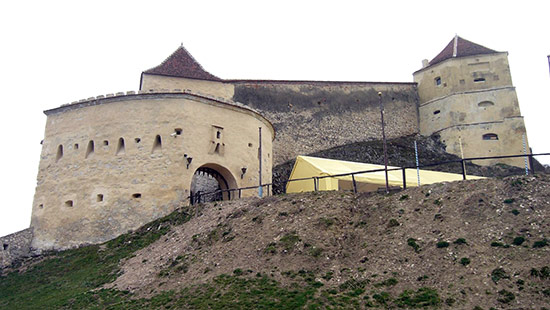
{banner-amintirien}

 Peles Castle
Peles Castle Bran Castle
Bran Castle Corvinilor Castle
Corvinilor Castle Brasov – Black Church
Brasov – Black Church





